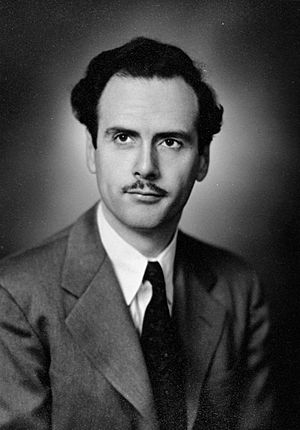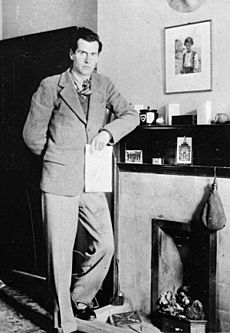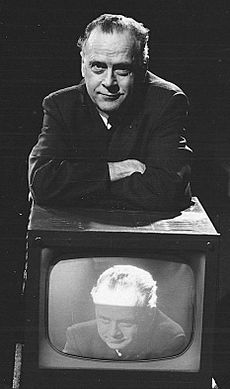Marshall McLuhan facts for kids
Quick facts for kids
Marshall McLuhan
|
|
|---|---|

McLuhan in 1945
|
|
| Born |
Herbert Marshall McLuhan
July 21, 1911 Edmonton, Alberta, Canada
|
| Died | December 31, 1980 (aged 69) Toronto, Ontario, Canada
|
| Alma mater | |
| Spouse(s) |
Corinne Lewis
(m. 1939) |
| Era | 20th-century philosophy |
| Region | Western philosophy
|
| School | Toronto School of communication theory |
| Institutions | St. Michael's College, Toronto |
| Doctoral advisor | M. C. Bradbrook |
| Doctoral students | Sheila Watson |
| Other notable students | Walter J. Ong |
|
Main interests
|
|
|
Notable ideas
|
The medium is the message, global village, figure and ground, tetrad of media effects, hot and cool media, media ecology |
|
Influences
|
|
|
Influenced
|
|
Herbert Marshall McLuhan (pronounced mə-KLOO-ən) (July 21, 1911 – December 31, 1980) was a Canadian thinker. He is known as one of the most important people in the study of media theory. This field looks at how different types of media, like TV or the internet, affect us.
McLuhan came up with famous ideas such as "the medium is the message" and the "global village." He even seemed to predict the World Wide Web almost 30 years before it existed. His ideas were very popular in the 1960s. After a while, interest in his work faded. But when the internet became big, people started looking at his ideas again.
Life and Career
Marshall McLuhan was born in Edmonton, Alberta, Canada, on July 21, 1911. His family moved to Winnipeg, Manitoba, where he grew up. He went to Kelvin Technical School and then the University of Manitoba.
College Years
McLuhan first studied engineering in college. But he soon changed his mind and studied English instead. He earned two degrees from the University of Manitoba. He then went to the University of Cambridge in England for more studies.
At Cambridge, he learned from important teachers like I. A. Richards and F. R. Leavis. They taught him to pay close attention to how things are presented. This way of thinking helped him develop his later ideas about technology. He earned his bachelor's degree from Cambridge in 1936.
Becoming a Catholic
While at Cambridge, McLuhan became interested in the Catholic Church. He officially became a Catholic in 1937. His faith was very important to him throughout his life. After this, he taught at Catholic universities.
Early Teaching and Family Life
McLuhan started teaching English in the United States. From 1937 to 1944, he taught at Saint Louis University. There, he met Corinne Lewis, a teacher and actress. They got married on August 4, 1939.
They spent a year in Cambridge, England, where McLuhan finished his master's degree. He also started his PhD work. Because World War II had started, he could finish his PhD from the United States. He earned his Doctor of Philosophy degree in 1943.
In 1946, the McLuhan family moved to Toronto, Canada. He joined the faculty at University of St. Michael's College, which is part of the University of Toronto. A fellow professor, Harold Innis, greatly influenced McLuhan's ideas about communication.
Later Career and Fame
In the early 1950s, McLuhan started special seminars at the University of Toronto. These seminars focused on communication and culture. He also published his first major book, The Mechanical Bride (1951). This book looked at how advertising affects society.
McLuhan's fame grew, and the University of Toronto created a special center for him in 1963. It was called the Centre for Culture and Technology. This was to keep him from moving to other universities.
From 1967 to 1968, McLuhan taught at Fordham University in New York. During this time, doctors found a harmless brain tumor, which was successfully treated. He then returned to the University of Toronto.
In 1970, he received a high honor in Canada, becoming a Companion of the Order of Canada. McLuhan and his wife, Corinne, had six children. Because of his large family, he often took on consulting and speaking jobs for big companies like IBM.
McLuhan even made a short appearance as himself in the famous movie Annie Hall (1977). In the movie, he surprises a man who is talking about his work without understanding it.
Death
In September 1979, McLuhan had a stroke, which made it hard for him to speak. He never fully recovered and passed away in his sleep on December 31, 1980. He is buried in Thornhill, Canada.
Major Ideas
McLuhan wrote several important books that explored how media shapes our lives.
The Mechanical Bride (1951)
McLuhan's first book, The Mechanical Bride: Folklore of Industrial Man, looked at popular culture. He analyzed many examples of advertising and how they tried to persuade people. He showed how ads use images and words to affect us.
This book was an early step towards his famous idea: "the medium is the message." This means that the way information is delivered (the medium) is more important than the information itself (the message).
The Gutenberg Galaxy (1962)
In The Gutenberg Galaxy: The Making of Typographic Man, McLuhan explored how communication technology changed human thinking and society. He looked at how writing, the printing press, and electronic media affected us.
The Printing Press
McLuhan argued that the invention of movable type (the printing press) in the 1400s was a huge change. Before printing, people mostly learned by listening and speaking. Printing made books widely available. This led to people reading more and thinking more visually.
He believed that printing helped create many modern ideas. These include individualism (focus on the individual), democracy, and nationalism. Printing made information spread faster and more widely than ever before.
The Global Village
McLuhan also introduced the idea of the "global village." He predicted that electronic media, like television, would connect people around the world. This would make the world feel like a small village. Everyone would be connected and share experiences instantly.
He saw this as a return to a "tribal" way of life, but on a global scale. People would move from being separate individuals to being part of a larger, connected group. McLuhan was interested in understanding these effects, not saying if they were good or bad. He believed it was important to be aware of how technology changes us.
Understanding Media (1964)
McLuhan's most famous book is Understanding Media: The Extensions of Man. In it, he argued that we often focus too much on what media says. Instead, we should focus on the media itself. This is where his famous phrase "the medium is the message" comes from.
For example, a light bulb doesn't have "content" like a TV show. But it changes society by allowing us to see at night. This shows how the medium (the light bulb) affects us just by existing. McLuhan believed that the type of media, like TV or books, changes how we think and act, no matter what specific shows or stories they carry.
"Hot" and "Cool" Media
In Understanding Media, McLuhan also talked about "hot" and "cool" media. This idea describes how much effort a person needs to put in to understand a medium.
- A hot medium gives you a lot of information. It doesn't need much effort from you. For example, a movie is "hot" because it gives you detailed pictures and sounds. You just watch and listen. Other hot media include radio and photographs.
- A cool medium gives you less information. It needs more effort and participation from you to fill in the gaps. For example, a comic book is "cool" because it has simple drawings. Your brain has to work harder to imagine the details. Television (especially older, blurry TV) and seminars are also "cool" media.
McLuhan said that hot media usually focus on one sense, like sight or hearing. Cool media involve more senses and require you to be more active.
The Medium Is the Massage (1967)
The Medium Is the Massage: An Inventory of Effects was McLuhan's best-selling book. The word "massage" here means the effect a medium has on our senses. The book showed how different media "massage" or change our senses.
This book was designed with a lot of images and different text styles. It made readers experience the ideas McLuhan was talking about. He also repeated his idea that all media are "extensions" of our human senses, bodies, and minds. For example, a car is an extension of our legs, and a phone is an extension of our voice.
Key Concepts
McLuhan developed several important ideas to help us understand media.
Tetrad of Media Effects
In his book Laws of Media (published after his death), McLuhan created the "tetrad of media effects." This is a way to look at how any technology affects society. It asks four questions about a medium:
- Enhancement: What does the medium make better or stronger?
- Obsolescence: What does the medium make less important or get rid of?
- Retrieval: What does the medium bring back that was lost before?
- Reversal: What happens when the medium is pushed to its extreme?
These four effects happen at the same time. For example, with radio:
- Enhancement: Radio makes news and music spread easily through sound.
- Obsolescence: It makes printed news and visual entertainment less important.
- Retrieval: It brings back the importance of the spoken word.
- Reversal: If pushed too far, radio (sound only) can turn into TV (sound and pictures).
Figure and Ground
McLuhan used the idea of "figure and ground" from Gestalt psychology. This helps explain "the medium is the message." The "figure" is the medium itself (like a TV). The "ground" is the environment or context in which the medium exists.
McLuhan believed that to truly understand a new technology, you must look at both the medium (figure) and its context (ground) together. They both affect each other. For example, the internet (figure) changes how we learn and connect (ground). In turn, our desire to learn and connect (ground) pushes the internet (figure) to develop further.
Legacy
After Understanding Media was published, McLuhan became very famous. He was probably the most well-known English teacher of the 20th century. Magazines like Newsweek and Life wrote about him.
McLuhan influenced many thinkers and writers. These include Neil Postman and Timothy Leary. Even Andy Warhol's famous quote about "15 minutes of fame" was inspired by McLuhan's ideas.
In Popular Culture
- A character in the 1983 film Videodrome was based on McLuhan.
- Wired magazine, which focuses on technology, called McLuhan its "patron saint" for many years.
- The band Genesis mentions him in their song "Broadway Melody of 1974."
- He is even mentioned in an episode of The Sopranos.
Recognition
After McLuhan's death, the McLuhan Program in Culture and Technology was created at the University of Toronto. It continues his work on media and technology.
In Toronto, a high school is named after him: Marshall McLuhan Catholic Secondary School. Also, the media room at Canada House in Berlin is called the Marshall McLuhan Salon. It has a permanent exhibit about his work.
Images for kids
See also
 In Spanish: Marshall McLuhan para niños
In Spanish: Marshall McLuhan para niños




